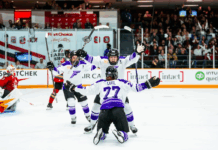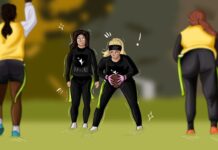Darnell Barnaby had been playing football since the age of eight, but he had never experienced an injury quite like this.
As doctors have progressively learned more about concussions, the diagnosis, treatment, and organization protocol of concussions with athletes has also changed.
“We (team physicians) no longer do sideline checks to see if [players] can return to play. We now know that symptoms can take 24-36 hours to actually evolve,” Dr. Taryn Taylor said. “Our approach has become much more conservative, now that we know you’re not going to have symptoms immediately.”
Barnaby, now a sophomore defensive end for the Carleton Ravens, was certain he had a concussion, but didn’t completely understand the severity of his injury at the time.
In football, most people gets their fair share of bumps and bruises. Barnaby had even suffered a torn medial collateral ligament in his knee, but nothing like this.
It happened back in high school, yet Barnaby can still clearly recall the events leading to the moment he found himself lying unconscious on the football field, surrounded by trainers.
“During a play, I got blindsided,” Barnaby said. “I was unconscious for four or five seconds. I sat out the whole second half after that and missed the rest of the game.”
Concussions in football are not unusual. Incidents such as Barnaby’s, however, are disturbingly common in contact sports. In Canada, concussions make up 93 per cent of the sports and recreation-related traumatic brain injuries (TBIs) among children and youth.
The attention given to TBIs in contact sports has increased in recent years, and because of this, a cultural revolution has been seen in all levels of sports, including the medical aspect.
When these incidents occur, responsibility falls on the medical staff, who have the tough task of managing the recovery process of these delicate injuries.
Taylor, the team physician for the Ottawa 67s and a staff member at the Carleton Sports Medicine Clinic, says she sees around five athletes per week for concussions. A lot of these injuries are self-reported.
“Education is probably the most important piece of it, because players need to know to report if they are feeling a bit off,” Taylor said. “As well as making sure coaching staff and therapists also recognize symptoms.”
The long road to recovery
“I’ve noticed how treatments have changed since my first concussion,” said Scott Quinn, a former lacrosse player who now studies at Western University.
Quinn has suffered multiple concussions, most recently in the spring of 2017 where he received a blindside hit that effectively ended his lacrosse career and has left him dealing with persistent concussion symptoms.
“It definitely affected my everyday life, I wasn’t able to attend classes,” Quinn said. “I still have accommodations at school because, at this stage in my concussion, the workload of a regular university student just wouldn’t be possible.”
Quinn said he was once optimistic about his chances of returning and playing for Western, but at this point, it’s just not worth it.
“I’d be putting myself at more risk, so right now, I don’t see myself returning to lacrosse,” he said.
For now, Quinn just focuses on getting better. It has been a lengthy recovery, but he has noticed progression both in his condition, and in the methods used by doctors to treat concussions.
“Neurologists have actually been using a lot of new research,” Quinn said, in reference to his weekly visits with specialists at the University of Toronto Sports Medicine Clinic.
At the clinic, Quinn undergoes vision therapy to help re-learn how to focus his eyes—a required exercise due to the brain trauma he sustained in his young athletic career.
This heightened awareness of brain injuries and movement towards more innovative treatment in contact sports is often attributed to recent findings surrounding the condition known as chronic traumatic encephalopathy (CTE).
CTE is a neurodegenerative disease caused by repeated blows to the head, leading to the loss of brain cells and serious cognitive problems later in life. It is most common in sports such as football, rugby and hockey.
Because CTE can only be diagnosed after death, research is still in the early stages. However, there have been several notable confirmed cases of CTE in recently-deceased athletes.
Washington State quarterback Tyler Hilinski, who died by suicide in January at the age of 21, was revealed to have CTE. Medical examiners concluded that at the time of his death he had the brain of a 65-year-old.
Other notable cases are former New England Patriots tight end Aaron Hernandez and National Football League Hall of Famer Junior Seau. Both men died by suicide.
In 2017, a study conducted by Boston University’s CTE Centre found the degenerative brain disease was present in 99 per cent of brains obtained from National Football League players, as well as 91 per cent of college football players. Alarmingly, the study also found CTE in the brains of 21 per cent of high school football players.
“The data suggest that there is very likely a relationship between exposure to football and risk of developing the disease,” said Jesse Mez, a Boston University School of Medicine assistant professor of neurology and lead author on the study.
Dr. Kristian Goulet, the medical director for the concussion clinic at the Children’s Hospital of Eastern Ontario, has his own opinion on CTE findings.
“When it comes to CTE, it’s still in its infancy,” Goulet said. He made it clear he doesn’t believe athletes should approach contact sports seeking head injuries, but also doesn’t want people to assume the human brain cannot recover from a concussion.
“I’ve seen patients coming in who’ve had one or two concussions and they think they have CTE, and that’s not what the literature points to either,” Goulet added. “We need to understand that our brains are strong, to a degree, and resilient.”
In light of recent studies, many leagues have implemented regulations to improve players’ safety. In 2013, Hockey Canada upped the age of body-checking from PeeWee (under 13) to Bantam (under 15).
Last year, the CFL abolished contact practices during the season. The league also added an extra official to the field to monitor blows to the head or neck of quarterbacks for the remaining games of this year’s playoffs.
In 2015, the Ontario University Athletics (OUA) put a rule in place for varsity football which limited contact practices to just three per week. Players have mixed opinions about this culture change in football.
“Every fully-padded practice, every time we have one of them, someone gets hurt,” said Barnaby. “Every single practice.”
The rule was put in place to prevent injuries in practice and limit contact, but as Barnaby points out, football is an aggressive game and injuries still occur.
Long-term health over everything
Second-year Carleton receiver Kerwin Guiste has suffered two previous concussions and is now recovering from a third one, this time from practice.
“I was running a certain route and had my head turned away from the defender,” Guiste said. “When I turned back, I ran into him as he tried to jump the play.”
The hit spun Guiste’s body, creating a whiplash effect as he hit the ground.
“I got up and felt kind of nauseous,” he added. “I took one step and fell back down because I couldn’t stand on my own.”
After the practice, Guiste became sensitive to noise and light, prompting the Ravens medical staff to enter him into concussion protocol.
Currently three-and-a-half-weeks into the concussion recovery process, Guiste has attempted to resume training, but is still experiencing symptoms.
But, despite all this, Guiste is concerned about how non-contact rules, such as the one the OUA put in place, are changing the game of football.
“I think it’s a good step, but I also think we shouldn’t take away from the game, what the game has always been,” he said. “We are tackling right now, but now we’re so safe that we can’t put our heads in a certain way because it causes a penalty. I think that’s what’s really changing the game.”
Guiste added that, because of the new rules, players need to adjust their hits according to how opponents come at them, which only complicates matters further.
Additionally, players find this rule can make it difficult to prepare for upcoming games.
“When you play teams like Western, who are guaranteed to be just as, if not more physical than your team is, then it’s hard to prepare when you are only limited to three practices,” Barnaby said.
However, other players are satisfied with limited contact in practices.
“At our level, we practice football enough that you should know when you actually have to use full contact,” Sam Bergeron said, a sophomore defensive lineman for the University of Guelph. “We’ve all practiced tackling for numerous years.”
When asked to what degree rule changes and recent concussion studies have had on changing football culture, Bergeron was very quick in his response.
“Entirely,” Bergeron said. He made it clear he is content with all aspects of the new changes made to the game.
“It definitely makes football a little safer,” he added.
As researchers at Boston University have pointed out, the clinical symptoms of CTE, such as depression and impaired cognitive function emerge later in life, usually after athletes retire from their sport.
Quinn said he continues to battle concussion symptoms that have plagued him for a large part of his adolescence, but he said he tries his best not to worry too much about any long-term cognitive issues.
“Honestly, it’s been in the back of my head a lot and has caused some worries, but I’ve kind of just adapted the mindset of ‘Don’t worry about if it’s going to affect you in the long run—just focus on getting better now,’” he said.
“Focus on being the healthiest, getting back to the healthiest you can be and hopefully that can set you up for a healthy life.”
Looking back on his athletic career, Quinn said he has no regrets.
“If I had the chance to go back and play sports again, I would,” he said. “The relationships that I built from sports, the friends I’ve made, I wouldn’t give it up. I knew the risk of playing these sports when I signed up for them and got passionate about them.”
Guiste said he sees the importance of a healthy life after football.
“I think there’s more than this game,” he said. “I do love it and I do want to make a career out of it, but I can only play this game for so long.”
Guiste and his family understand concussions are a serious matter, so they have set some pretty solid boundaries going forward.
“My Dad has told me that if I get another concussion I should stop. So, I keep that in mind,” Guiste said. “If I get another concussion, that’s it for me, no matter where I am, no matter where I’m going [in football].”
Photo by Samantha Pope






